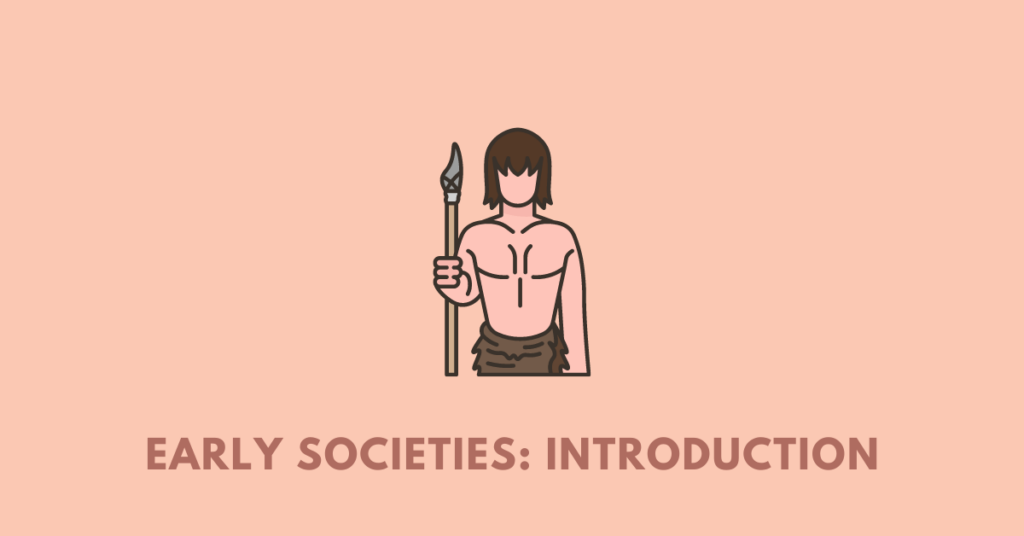Get summary, textual answers, solutions, notes, extras, PDF to NBSE Class 11 (Arts) History (Themes in World History) Section A: Early Societies (Introduction) . However, the educational materials should only be used for reference and students are encouraged to make necessary changes.
Summary
The “Early Societies” section discusses two themes. The First Theme focuses on the beginning of human existence, examining early human life, shelters, food, and significant developments like the discovery of fire and the use of language. The Second Theme explores early cities, particularly those in Mesopotamia, and the various people who lived there, including craftsmen, scribes, laborers, priests, kings, and queens. The shift from nomadic life to settled agricultural life, which began 10,000 years ago, led to the domestication of animals, the weaving of cloth, and the development of pottery and metal tools. Over time, trade emerged, connecting people from distant places and providing access to various goods. The growth of small cities led to the transformation of human life, which some scholars describe as a revolution.
Extra/additional questions and answers
Q. How did archaeologists create the history of early phases of human life?
Answer: Archaeologists created the history of early phases of human life by examining the remains of bones and stone tools, and by trying to find out the shelters in which early humans lived, and the food they ate.
Q. How did the shift from nomadic life to settled agricultural life impact human lives?
Answer: The shift from nomadic life to settled agricultural life had a significant impact on human lives. First, they began to domesticate animals such as sheep, goats, cattle, and pigs. Second, they started weaving cloth with the help of plant fibers (like cotton) and animal fibers (such as wool). They also domesticated animals and harnessed them to plows and carts, and carried loads on their backs.
Q. What were the stages of evolution of early societies and cities?
Answer: The stages of evolution of early societies and cities started with people living as hunters and gatherers in forests, caves, or temporary shelters for millions of years. The shift from nomadic life to settled agricultural life began 10,000 years ago. Settled agriculture led to the domestication of animals, weaving of cloth, and the use of fire for cooking. The development of pottery, stone tools, and metal tools followed. With time, trade emerged, and people procured goods from distant places. The growth of small cities quickened the pace of change, transforming the lives of humans and leading to the emergence of small states.
Q. What are some examples of other kinds of early societies besides hunters and gatherers and city dwellers?
Answer: Some examples of other kinds of early societies include farming communities and pastoral communities. These communities engaged in agriculture and animal husbandry, respectively, to meet their needs for sustenance and materials.
Q. How did the use of metals impact early societies?
Answer: The use of metals impacted early societies by providing more durable materials for making tools and jewelry, enhancing their daily lives and trade capabilities.
Q. How did the lives of humans transform due to the growth of small cities and the emergence of trade?
Answer: The growth of small cities and the emergence of trade transformed human lives in several ways. First, the increasing need for resources and the development of trade networks expanded human interactions and fostered cultural exchanges. Second, the growth of cities led to the specialization of labor and the rise of various social classes, such as craftsmen, scribes, laborers, priests, kings, and queens. Third, the development of writing systems to manage trade, administration, and communication played a crucial role in the functioning of early cities. Fourth, the exchange of goods from distant places, such as wood, stones, precious and semi-precious stones, metals, shells, and hardened volcanic lava, contributed to the diversification and enrichment of human societies. These changes came slowly and took several thousand years, but eventually led to a revolution in human life, with a transformation that was beyond recognition.
Extra/additional MCQs
Q. Where did human beings first appear?
A. Asia B. Europe C. Africa D. Australia
Answer: C. Africa
Q. What significant development allowed early humans to cook food?
A. Agriculture B. Domestication C. Fire D. Language
Answer: C. Fire
Q. What region is Mesopotamia a part of in modern times?
A. Iran B. Turkey C. Iraq D. Syria
Answer: C. Iraq
Q. What led to the shift from nomadic life to settled agricultural life?
A. Trade B. Writing C. Religion D. Domestication
Answer: D. Domestication
Q. Which animals were domesticated by early agricultural societies?
A. Elephants B. Sheep C. Horses D. Kangaroos
Answer: B. Sheep
Q. What fibers were used to weave cloth in early societies?
A. Silk B. Flax C. Cotton D. Hemp
Answer: C. Cotton
Q. What were early pots used for?
A. Cooking B. Storage C. Decoration D. Art
Answer: B. Storage
Q. What material was used to tip the ores in some early societies?
A. Copper B. Bronze C. Iron D. Tin
Answer: A. Copper
Q. What types of goods were procured from distant places by early societies?
A. Food B. Pottery C. Metals D. Textiles
Answer: C. Metals
Q. What term is used to describe the transformation of human life due to the growth of small cities and emergence of trade?
A. Evolution B. Revolution C. Progress D. Renaissance
Answer: B. Revolution
Get notes of other boards, classes, and subjects
